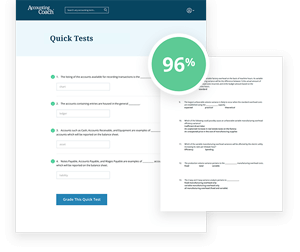For multiple-choice and true/false questions, simply press or click on what you think is the correct answer. For fill-in-the-blank questions, press or click on the blank space provided.
If you have difficulty answering the following questions, learn more about this topic by reading our Financial Ratios (Explanation).
Inventory
Prepaid Insurance
Fixtures
Current Ratio
Net Worth
Working Capital
Current Ratio
Net Worth Ratio
Working Capital
Accounts Receivable
Inventory
Cash
Use the following information to answer items 5 – 7:
At December 31 a company’s records show the following information:
$60,000
$66,000
$196,000
1.0 : 1
2.0 : 1
2.1 : 1
0.7 : 1
1.0 : 1
2.0 : 1
Use the following information to answer items 8 – 11:
For its most recent year a company had Sales (all on credit) of $830,000 and Cost of Goods Sold of $525,000. At the beginning of the year its Accounts Receivable were $80,000 and its Inventory was $100,000. At the end of the year its Accounts Receivable were $86,000 and its Inventory was $110,000.
4.8
5.0
7.9
6.3
7.5
10.0
27
37
49
14
46
73
Use the following information for items 12 and 13:
A company’s net income after tax was $400,000 for its most recent year. The company’s income statement included Income Tax Expense of $140,000 and Interest Expense of $60,000. At the beginning of the year the company’s stockholders’ equity was $1,900,000 and at the end of the year it was $2,100,000.
6.7
9.0
10.0
20%
25%
30%
Current Assets
Long-term Assets
Stockholders' Equity
True
False
True
False
True
False
Operating
Investing
Financing

Get Our Premium Financial Ratios Test Questions When You Join PRO
Receive instant access to our entire collection of premium materials, including our 1,800+ test questions.
View All PRO Features

Join PRO or PRO Plus and Get Lifetime Access to Our Premium Materials
Read all 3,033 reviewsFeatures
PRO
PRO Plus
Read 3,033 Testimonials